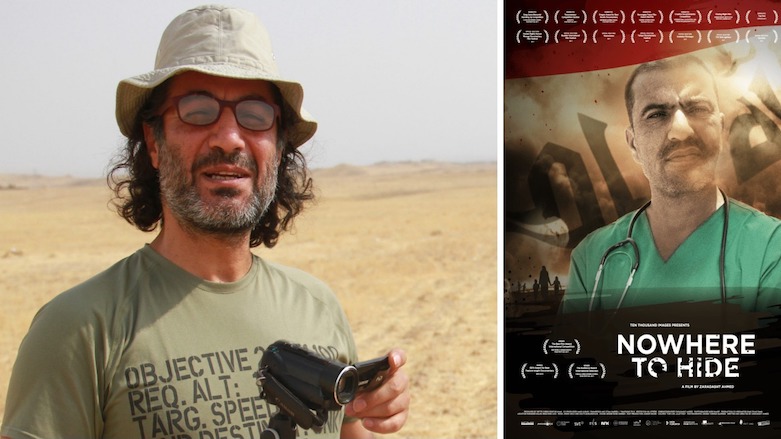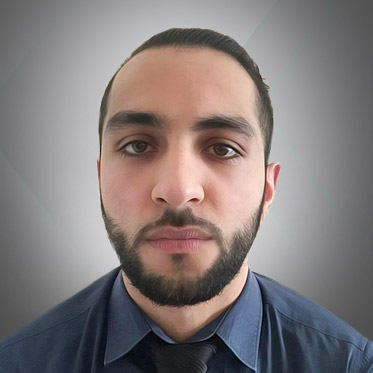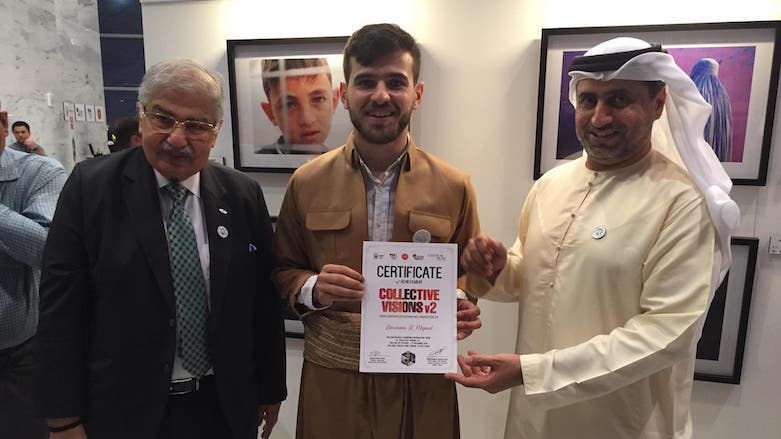Kurdish filmmaker’s award-winning documentary on Iraq airs on PBS

ERBIL (Kurdistan 24) – A moving film filled with raw emotion and unfiltered footage, Kurdish filmmaker Zaradasht Ahmed’s award-winning documentary “Nowhere to Hide” made its US broadcast on PBS on Monday.
The feature-length documentary follows the life of a male nurse, Nori Sharif, who, like many civilians, finds himself trapped in the crossfire of an unpredictable war in Iraq.
The film covers a five-year period from 2011, when the United States pulled its forces from Iraq eight years after the toppling of Saddam Hussein’s regime, until 2016, well into the latest threat in the country in the form of the so-called Islamic State (IS).
Kurdistan 24 spoke with the filmmaker about the documentary which he explained highlights the ongoing sorrow of innocent humans who suffer due to the decisions of political leaders.
A HUMANISTIC APPROACH
The film provides a first-hand account of humans caught in the crossfire of war. It sheds light on the ongoing crisis of Internally Displaced Persons (IDPs) and refugees in the IS war in Iraq.
Ahmed said it is important to speak about these IDPs and refugees as individuals rather than just a group. Although his film provides a significant contribution to raising awareness about the crisis, the Kurdish filmmaker said the time for raising awareness has long passed.
“It’s not time to raise awareness because the problem is already there, but maybe the time to find a solution on how we can help, how we can affect other people, [and influence] decision makers to help.”
The Kurdistan Region continues to provide a haven for millions of IDPs and refugees who have fled the conflict in central and southern parts of Iraq, as well as Syria, as efforts to reconstruct liberated areas and provide security for the displaced are not complete.
Ahmed said one major solution to resolve the crisis is to guarantee safety. “Those areas like Mosul are not safe. Diyala is not safe. Anbar is not safe. Usually, it’s a political problem because people still feel the agony of losing their lives and houses and cannot criticize anything because they will be kidnapped or killed,” he told Kurdistan 24.
“So, first of all, this is the thing: whether it’s in Syria, Iraq, Yemen, or Libya, you have to go in locally to force the government to start work properly in all the sections of the society and start to build the country. That’s the hope for people. Even people from outside the country will go back and help to build, but nothing like that has happened.”
The main character in “Nowhere to Hide” is one example of the suffering innocent civilians are forced to endure due to war, specifically the instability of the Iraq war and its aftermath.
“We need to talk about the bigger picture,” Ahmed noted. “We cannot just talk of IDPs or refugees. Refugees are part of a problem, it’s a reaction from a problem, but the problem itself is not the IDP or the refugee, it’s the war.”

“The IDPs are not the question; it’s the war and the safety, livelihood. If you cannot secure safety for your kids to guarantee they have food on the table, you have to do something about it. You leave, or you stay where you are to feed them. So, we have to go and make people feel safe again, [and believe] in the idea that ‘this is my country, this is my place, I can build it, it will not be destroyed again.’”
‘NOWHERE TO HIDE’
The documentary was a product of years of work, and the framework of the final product evolved as the conflict in Iraq molded from one terror to another. In December 2011, America announced it was withdrawing its troops from the country.
Ahmed told Kurdistan 24 the idea for the film existed back in 2010 before the American withdrawal. He said he wanted to make a documentary about the war in Iraq while the US troops were still there but the idea evolved with the rise in conflict in the country.
“There was a lot of escalation of violence, and there was a lot of internal conflicts, and the Americans were struggling to get it right, to manage the country, and there were questions of whether that was deliberate or just failure.
“So, I wanted to explore that, but then when I was there, I realized it was almost impossible to be in those areas, in central Iraq, at that time because al-Qaeda was very efficient in those areas and they were killing people who cooperated with the media, and outsiders.
“While we were filming, the Americans pulled out, and we decided to stay [in Iraq] to see how things would go after their withdrawal, but things were going from bad to worse.”
Ahmed said the film took six years to finish due to the “shifting in politics, and also the violence level in Iraq.”
“The film was meant to be emotional without borders, to make people attached to those who are involved in the film emotionally and not in a factual or news-based medium. So, of course, the period [2011 to 2016] helped us form the film the way you see it because it took six years to finish it. There was non-stop filming during these six years,” he explained.
The Kurdish filmmaker said capturing certain scenes were difficult, and there was always an element of uncertainty over including some footage, like the aftermath of mass killings, suicide bombings, and car bombings.
Ahmed said he decided to use the footage “because that was the pain the people were going through, not because it was sensational but more rather that it was painful.”
“That was the population’s pain which they were going through. That was the real pain. So, we decided to use it.”

NORI SHARIF
Sharif, the main character in the film, was among a dozen medics who had accompanied Ahmed in Iraq. Within one year, the Kurdish filmmaker coached the group of medics on how to film and conduct qualitative interviews, similar to the methods used in medical research.
However, as the conflict in Iraq worsened following the American withdrawal, Sharif came more into focus.

“In 2012, when the violence was escalating, he [Sharif] was providing footage of lots of those first-hand accidents, attacks, suicide bombings, and car bombs,” Ahmed stated.
“I’m talking about 2011 and 2012 where the phenomenon [of suicide bombing] was not well-known. It was still very shocking when IS first began its mass killings. Those images were not very well-known.”
According to Ahmed, Sharif was “one of the most committed persons in the group” which is why he stays until the end and becomes the central figure of the documentary.
Sharif’s identity as a Sunni Arab was not revealed in the film. The Kurdish filmmaker explained that he chose not to make a political film “because that would be like putting oil on fire and that could have made the film more difficult, and complicated, and not human.”



“I decided just to portray a medic who is blind on the issues such as ethnicity and religion; he’s just doing his job equally for everybody. That was the strength. [Sharif] was helping a lot of people, going to their homes, they were Shias, they were Kurds, and they were Sunnis. So, for me, that’s why I was trusting him, he was the character that I could put a lot of effort into.”
Sharif and his wife, along with their children, currently live in the Saad IDP camp in Baqubah Province, which is under the administration of the Iraqi government. According to Ahmed, Sharif is happy and works at a clinic at the camp’s health center and still has hopes that things in Iraq will return to normal.
INTERNATIONAL REACTION
Since its first screening in 2016, “Nowhere to Hide” has picked up several prestigious awards including the International Documentary Film Festival Amsterdam (IDFA) prize for the Best Feature-Length Documentary in 2016 and the Amanda Award for Best Documentary in 2017.
Despite these achievements, Ahmed said before the prizes, the film itself has helped him achieve levels he had not dreamed of before.
“I managed to talk to thousands of people through the film. I managed to promote my ideas, my thoughts, my humanity, my story—like you know, Nori’s story—out to the world. So, the film was so powerful it touched anyone who watched it.”

Winning awards is “big because it helped the film to travel and get attention and have a long life. And now ‘Nowhere to Hide’ has lived three years. It’s in its third year and still has a lot of demands which is very good. Not too many films live over one year. Prizes are good which will help the film travel and reach more audiences,” he told Kurdistan 24.
“Nowhere to Hide” will make its US broadcast premiere on the POV series on PBS on Monday at 10:00 p.m. (5:00 a.m. Erbil time) and will stream on the POV website from Aug. 27 to Sep. 25, 2018.

